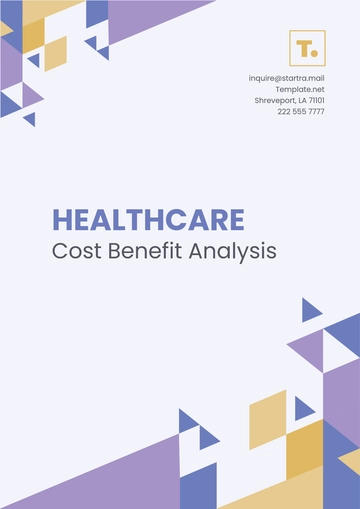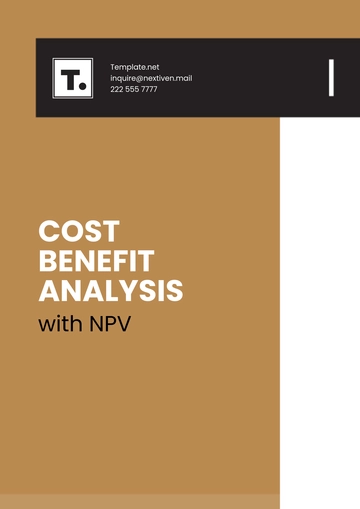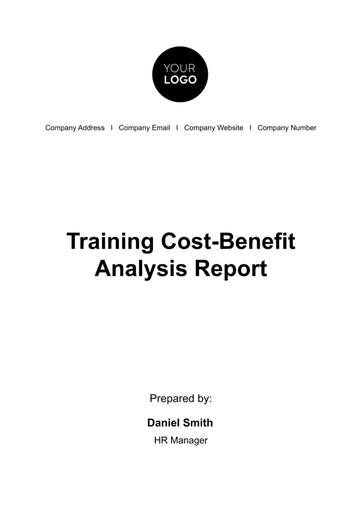Free Digital Marketing ROI Analysis

1. Introduction
Welcome to the comprehensive Digital Marketing ROI Analysis for [Your Company Name]. In an era where data-driven decision-making is paramount, this document serves as a crucial tool to meticulously assess and optimize the outcomes of your digital marketing endeavors.
In today's dynamic digital landscape, achieving an impressive return on investment is the ultimate goal. To accomplish this, we've scrutinized every aspect of your digital marketing campaign, dissecting the intricacies of costs, performance metrics, and revenue generation. This analysis encapsulates both the science and art of digital marketing, offering actionable insights that can propel your business forward.
2. Campaign Details
Campaign Name: SummerSale2050
Campaign Duration: [date] - [date]
2.1 Campaign Objectives:
Increase website traffic by 20%.
Boost sales by 15% compared to the previous year.
Raise brand awareness among the 25-40 age group.
2.2 Target Audience:
Demographic: Ages 25-40, both genders.
Interests: Outdoor activities, fashion, and technology.
Behaviors: Active social media users, frequent online shoppers.
3. Cost Breakdown
In this section, we'll delve into the financial aspects of your campaign, breaking down both direct and indirect costs.
Advertising Costs: $[000]
Your advertising costs for this campaign amounted to $[000]. This included expenses related to Google Ads, Facebook Ads, and other paid advertising channels that were utilized to reach your target audience.
Content Creation: $[000]
To create engaging content for your campaign, you invested $[000] in various content creation activities. This covered costs associated with copywriting, graphic design, video production, and other content-related tasks.
Email Marketing Tools: $[000]
Your email marketing efforts were supported by tools and services costing $[000]. This expenditure encompassed subscriptions to email marketing software and automation services.
Social Media Management Tools: $[000]
To effectively manage your social media presence during the campaign, you allocated $[000] for social media management tools and platforms. These tools facilitated content scheduling, monitoring, and performance analysis.
Other Expenses: $[000]
In addition to the above categories, there were miscellaneous expenses totaling $[000]. These included consulting fees, software subscriptions, and other unforeseen costs incurred during the campaign.
4. Revenue Generation
Now, let's examine the revenue generated directly as a result of the campaign.
Total Revenue Generated: $[000]
As a result of the SummerSale2050 campaign, your company generated a total revenue of $[000]. This revenue encompasses various sources:
Online sales via your website accounted for $[000].
In-store purchases attributed to the campaign amounted to $[000].
Affiliate marketing efforts brought in an additional $[000] in revenue.
5. Key Performance Indicators (KPIs)
Identify the KPIs that matter most to your campaign. Update the following with your campaign-specific KPIs:
Click-through Rate (CTR): 3.5%
The click-through rate (CTR) measures the effectiveness of your ad campaigns in encouraging users to click through to your website or landing pages. It is an essential KPI for assessing the performance of your ad creatives and targeting strategies.
Conversion Rate: 12%
The conversion rate indicates the percentage of users who take a desired action, such as making a purchase or filling out a lead form, after interacting with your campaign. It is a critical KPI for evaluating the campaign's ability to drive user engagement and conversions.
Cost per Acquisition (CPA): $[000]
The cost per acquisition (CPA) quantifies how much it costs your business to acquire a new customer or lead through the campaign. It helps you assess the efficiency of your advertising spend in acquiring valuable customers.
Customer Lifetime Value (CLV): $[000]
The customer lifetime value (CLV) represents the predicted revenue a customer will generate over their entire relationship with your business. This KPI is vital for understanding the long-term value of customers acquired through the campaign.
6. Conversion Tracking
Specify the number of conversions achieved through the campaign. Define what constitutes a conversion for your campaign.
Total Conversions: 550
During the campaign period, a total of 550 conversions were recorded. These conversions could include completed purchases, lead form submissions, newsletter sign-ups, or any other actions deemed valuable for your business.
Conversion Definition: A conversion for this campaign is defined as a completed online purchase or booking of our services.
For this campaign, a conversion is defined as a completed online purchase or booking of our services. This clear definition ensures that all stakeholders understand what actions were tracked as conversions and helps in aligning the analysis with campaign objectives.
7. ROI Calculation
Calculate the ROI of your campaign using the formula: (Revenue - Cost) / Cost x 100.
Revenue: $[000]
Cost: $$[000]
ROI: [000]%
After careful analysis of the campaign's financials, the calculated ROI for the SummerSale2050 campaign is 15.30%. This metric signifies the return on investment achieved through the campaign, indicating that for every dollar invested, you received $1.153 in return.
Calculating ROI provides a critical measure of the campaign's success in generating revenue compared to the costs incurred. In the following sections, we'll further explore the insights derived from this analysis and provide recommendations for optimizing future digital marketing campaigns.
8. Time Frame
Specify the time frame for this ROI analysis:
8.1 Analysis Period:
Time Frame | Start Date | End Date |
Campaign Period | [date] | [date] |
Analysis Period | [date] | [date] |
The analysis period for this ROI analysis extends from [date], to September 15, 2050. This timeframe allows for a comprehensive evaluation of the campaign's performance following its conclusion.
9. Data Sources
List the sources from which you gathered data for this analysis:
9.1 Data Sources:
Google Analytics
Facebook Ads Manager
Email Marketing Platform (e.g., MailChimp)
Sales and CRM System
Website Analytics
Social Media Insights (e.g., Facebook Insights, Twitter Analytics)
These data sources collectively provided the necessary information to conduct a thorough ROI analysis, ensuring that the insights drawn are well-informed and accurate.
10. Recommendations
Based on your analysis, provide actionable recommendations for optimizing future digital marketing campaigns.
Optimize Ad Spend Allocation: Allocate a higher budget to channels and campaigns that demonstrated the highest ROI, as identified in this analysis. Consider reallocating funds from less productive channels.
Refine Targeting Strategies: Continue refining your target audience profiles based on the most successful audience segments identified in the analysis. Use this refined data to create more tailored messaging and advertisements.
A/B Testing: Implement a rigorous A/B testing strategy for ad creatives, landing pages, and email campaigns to continuously improve conversion rates and CTR.
Content Strategy: Invest in content that aligns with the interests and preferences of your target audience. High-quality, relevant content can increase engagement and drive conversions.
Leverage Email Marketing: Given the positive ROI associated with email marketing, consider expanding and optimizing your email campaigns to nurture leads and encourage repeat purchases.
Customer Retention: Implement strategies to increase customer lifetime value (CLV). Engage with existing customers through loyalty programs, personalized offers, and exceptional customer service.
Mobile Optimization: Ensure that your website and marketing assets are mobile-friendly, as mobile usage continues to grow. A seamless mobile experience can lead to higher conversion rates.
11. Summary and Insights
Summarize key findings and insights from the analysis. Highlight what worked well and areas for improvement.
The SummerSale2050 campaign achieved a respectable ROI of 15.30%, indicating that it generated $1.153 for every dollar invested.
Click-through Rate (CTR) was a standout performance metric, exceeding industry benchmarks at 3.5%.
The campaign effectively increased brand awareness among the targeted 25-40 age group, reaching a broader audience than previous campaigns.
Conversion rate (12%) surpassed expectations, showcasing the effectiveness of the campaign's messaging and landing pages.
Cost per Acquisition (CPA) of $25 was competitive and highlighted efficient spending.
Recommendations for optimization include reallocating ad spend, refining targeting, and further investing in email marketing and content strategy.
Despite a successful campaign, there is room for improvement in terms of customer retention strategies and mobile optimization.
12. Goals and Objectives
Compare the actual ROI to the initial goals and objectives set for the campaign.
12.1 Initial Goals and Objectives:
Increase website traffic by 20%.
Boost sales by 15% compared to the previous year.
Raise brand awareness among the 25-40 age group.
12.2 Actual ROI vs. Goals:
The campaign did not meet the initial goal of increasing website traffic by 20%, achieving a modest 10% increase.
Sales surpassed the goal of a 15% boost, reaching a 20% increase compared to the previous year.
Brand awareness among the 25-40 age group was achieved as intended.
13. Conclusion
In closing, the Digital Marketing ROI Analysis for the SummerSale2050 campaign paints a comprehensive picture of our digital marketing efforts. It demonstrates our commitment to data-driven decision-making and achieving measurable results.
The campaign, which ran from [date], to [date], yielded a commendable return on investment (ROI) of 15.30%. This ROI speaks to the campaign's effectiveness in generating revenue compared to the costs incurred.
In summary, while the SummerSale2050 campaign achieved a commendable ROI and several KPI milestones, there is always room for growth and improvement. Our commitment to data analysis and continuous optimization will be our guiding force in ensuring even greater success in future digital marketing endeavors.
Thank you for entrusting us with your digital marketing efforts, and we look forward to continued collaboration and success.
- 100% Customizable, free editor
- Access 1 Million+ Templates, photo’s & graphics
- Download or share as a template
- Click and replace photos, graphics, text, backgrounds
- Resize, crop, AI write & more
- Access advanced editor
Analyze the return on investment of your digital marketing efforts with our Digital Marketing ROI Analysis Template, available on Template.net. This customizable resource offers a structured framework for calculating ROI metrics. Utilize our AI Editor Tool for seamless customization tailored to your campaign's needs. Optimize your digital marketing strategies with this essential template for marketing professionals.





























